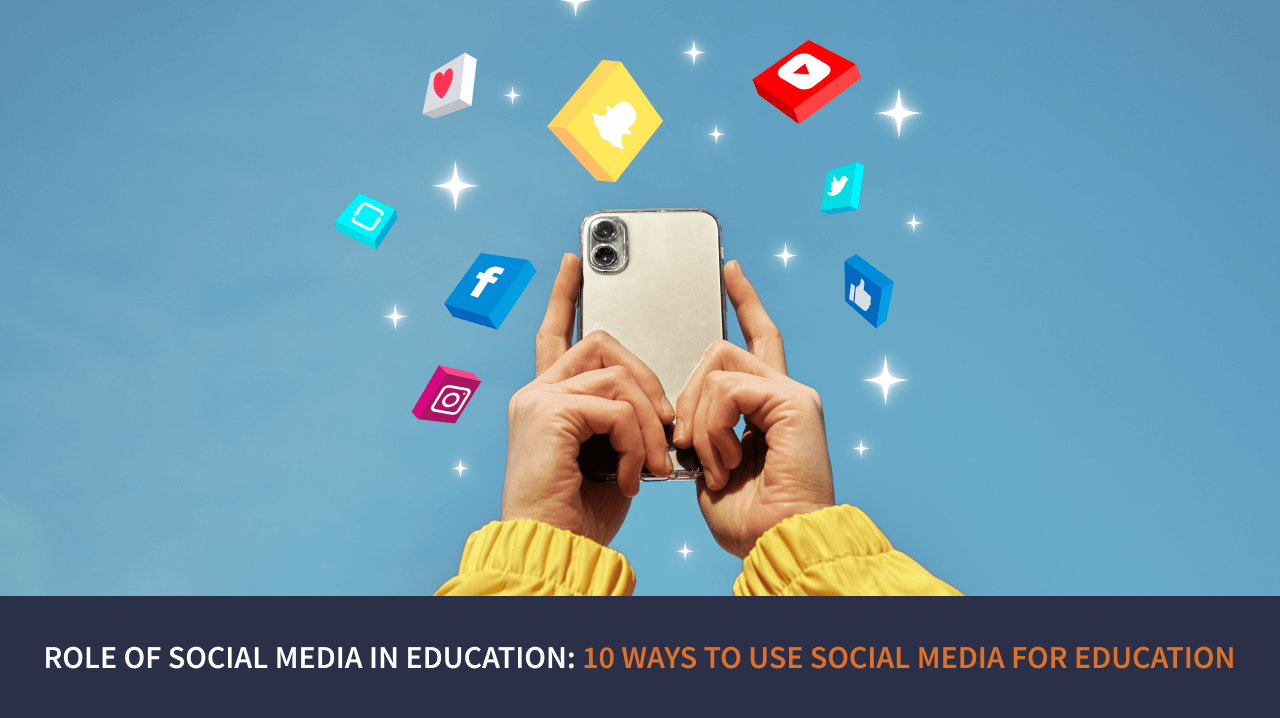Role of Social Media in Education: 10 Ways To Use Social Media For Education

Social media has become an integral part of modern society, with billions of people using various platforms to connect, communicate, and share information. In recent years, social media has also made its way into the field of education, transforming the way students learn and educators teach.
In this digital age, it is becoming increasingly important for educators and institutions to incorporate social media into their teaching methods. As technology continues to advance, social media will continue to play an essential role in education, helping to shape the future of learning and preparing students for success in the 21st century.
Role/Advantages Using Social Media For Education
- Increased Engagement And Motivation
Social media platforms allow students to connect with each other and with their teachers outside of the classroom, which can create a sense of community and foster a deeper interest in the subject matter.
- Encourages Collaboration And Teamwork
Social media platforms encourage collaboration and teamwork among students, which can help to improve their problem-solving and communication skills.
- Provides Opportunities For Personalized Learning
Social media can provide opportunities for personalized learning, as students can access a wide range of resources and educational content that is tailored to their individual needs and interests.
- Promotes Student-teacher Communication
Social media platforms can help to promote communication and interaction between students and teachers, which can improve student learning outcomes.
- Offers Access to Global Resources
By leveraging the power of social media, educators can help to create a more globalized and interconnected learning experience for their students.
10 Ways to Use Social Media For Education
Here are 10 ways in which social media can be used for education:
1. Facilitating online discussion groups to encourage collaboration and interaction between students.
2. Sharing educational videos and podcasts to provide supplemental materials and enhance students’ understanding of the subject matter.
3. Using social media platforms for research projects, allowing students to share information and resources and work together on research assignments.
4. Organizing virtual field trips to enhance students’ learning experience and expose them to new ideas and concepts.
5. Conducting polls and surveys to gather feedback from students and improve the quality of instruction.
6. Sharing news and updates related to the subject matter to keep students informed and engaged.
7. Providing access to online learning resources such as e-books, articles, and online courses to supplement classroom learning.
8. Encouraging blogging and reflective writing to help students develop their writing skills and reflect on their learning experience.
9. Offering opportunities for peer review to encourage collaboration and provide feedback to students.
10. Promoting digital literacy by teaching students how to use social media platforms safely and responsibly, and helping them develop critical thinking and research skills.
* 5 Simple Daily Habits to Reduce Stress & Improve Focus
* Six Tips for Establishing Good Homework Habits in Your Child
* List of Top 10 Freedom Fighters of India
* The Impact of Teacher-Student Relationships on Academic Success
* Top 10 Impressive & Interesting English Speech Topics for Students
Drawbacks And Challenges of Using Social Media in Education – How to Overcome From it
While social media can be a valuable tool in education, it also presents several drawbacks and challenges that need to be addressed. Here are some of the common drawbacks of using social media in education and ways to overcome them:
- Distraction
Social media can be a major distraction for students and can negatively impact their learning. To overcome this, educators can set clear guidelines for social media use during class time, such as limiting access to certain platforms or requiring students to keep their phones on silent.
- Cyberbullying
Social media can also be a platform for cyberbullying, which can have a detrimental effect on students’ mental health and well-being. Educators can address this issue by promoting safe and responsible social media use and implementing policies and procedures for reporting and responding to cyberbullying incidents.
- Privacy and security concerns
Social media platforms can pose privacy and security risks for students, as their personal information and online activity can be easily accessed by others. Educators can address these concerns by educating students about online privacy and security and encouraging them to use strong passwords and privacy settings.
- Inappropriate content
Social media platforms can contain inappropriate content that is not suitable for students. To overcome this, educators can use content filtering tools and monitor social media activity to ensure that students are not exposed to inappropriate content.
- Lack of access
Not all students have access to social media platforms, which can create disparities in learning and engagement. To overcome this, educators can provide alternative means of communication and collaboration for students who do not have access to social media, such as email or discussion forums.
Faq’s:
Social media is used in various ways, some of which are:
- Communication and collaboration
- Content sharing
- Online learning
- Research and information gathering
- Feedback and evaluation
Social media has transformed the way education is delivered and received, making it more accessible, engaging, and inclusive for students of all ages and backgrounds. As technology continues to evolve, social media will likely play an increasingly important role in the field of education.
The impact of social media on students can be both positive and negative. Some of the positive impacts are:
- Improved communications
- Access to informat
- Collaborative learning
- Career development
Negative impact includes
- Distraction
- Cyber bullying
- Misinformation
- Addiction
Social media can enhance the learning experience for students and provide opportunities for more personalized and engaging education. By leveraging the benefits of social media in education, educators can help to prepare students for the future and equip them with the skills they need to succeed in a rapidly changing world.


